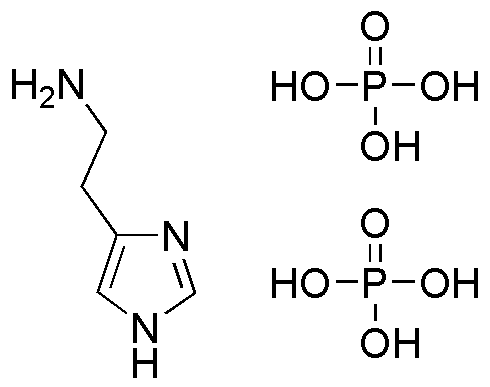Histamine diphosphate salt is widely utilized in research focused on:
- Pharmaceutical Development: It serves as a key ingredient in the formulation of antihistamines, aiding in the treatment of allergic reactions and asthma.
- Neuroscience Research: This compound is used to study neurotransmitter systems, particularly in understanding the role of histamine in brain function and behavior.
- Immunology: Researchers employ it to investigate immune responses, particularly how histamine influences inflammation and allergic reactions.
- Diagnostic Tools: It is utilized in assays and tests to measure histamine levels in biological samples, providing insights into various health conditions.
- Food Industry: The compound is explored for its potential in food preservation and safety, particularly in controlling microbial growth.
Informations générales
Propriétés
Sécurité et réglementation
Applications
Histamine diphosphate salt is widely utilized in research focused on:
- Pharmaceutical Development: It serves as a key ingredient in the formulation of antihistamines, aiding in the treatment of allergic reactions and asthma.
- Neuroscience Research: This compound is used to study neurotransmitter systems, particularly in understanding the role of histamine in brain function and behavior.
- Immunology: Researchers employ it to investigate immune responses, particularly how histamine influences inflammation and allergic reactions.
- Diagnostic Tools: It is utilized in assays and tests to measure histamine levels in biological samples, providing insights into various health conditions.
- Food Industry: The compound is explored for its potential in food preservation and safety, particularly in controlling microbial growth.
Documents
Fiches de données de sécurité (FDS)
La FDS fournit des informations de sécurité complètes sur la manipulation, le stockage et l’élimination du produit.
Spécifications du produit (PS)
Le PS fournit une description complète des propriétés du produit, notamment sa composition chimique, son état physique, sa pureté et les exigences de stockage. Il détaille également les plages de qualité acceptables et les applications prévues du produit.
Certificats d'analyse (COA)
Recherchez des certificats d'analyse (COA) en saisissant le numéro de lot du produit. Les numéros de lot et de lot se trouvent sur l'étiquette d'un produit, après les mots « Lot » ou « Lot de fabrication ».
Numéro de catalogue
Numéro de lot/série
Certificats d'origine (COO)
Ce certificat d'exploitation confirme le pays dans lequel le produit a été fabriqué, et détaille également les matériaux et composants utilisés et s'il est issu de sources naturelles, synthétiques ou autres sources spécifiques. Ce certificat peut être requis pour les douanes, le commerce et la conformité réglementaire.
Numéro de catalogue
Numéro de lot/série
Fiches de données de sécurité (FDS)
La FDS fournit des informations de sécurité complètes sur la manipulation, le stockage et l’élimination du produit.
DownloadSpécifications du produit (PS)
Le PS fournit une description complète des propriétés du produit, notamment sa composition chimique, son état physique, sa pureté et les exigences de stockage. Il détaille également les plages de qualité acceptables et les applications prévues du produit.
DownloadCertificats d'analyse (COA)
Recherchez des certificats d'analyse (COA) en saisissant le numéro de lot du produit. Les numéros de lot et de lot se trouvent sur l'étiquette d'un produit, après les mots « Lot » ou « Lot de fabrication ».
Numéro de catalogue
Numéro de lot/série
Certificats d'origine (COO)
Ce certificat d'exploitation confirme le pays dans lequel le produit a été fabriqué, et détaille également les matériaux et composants utilisés et s'il est issu de sources naturelles, synthétiques ou autres sources spécifiques. Ce certificat peut être requis pour les douanes, le commerce et la conformité réglementaire.


